Related Research Articles

The RA-14 Loisirs was a French two-seat high-wing light touring aircraft designed by Roger Adam shortly after World War II.

SNCAC was a French aircraft manufacturer created by the nationalisation of the Farman Aviation Works and Hanriot firms in 1936.

The Aubert PA-20 Cigale, PA-204 Cigale Major and PA-205 Super Cigale were a family of high-wing cabin monoplanes built in France in the years immediately before and immediately after World War II. The original Cigale was shown at the 1938 Paris Salon but its development was interrupted by the War. The Cigale was a high-wing cantilever monoplane of conventional configuration with fixed, tailwheel undercarriage.
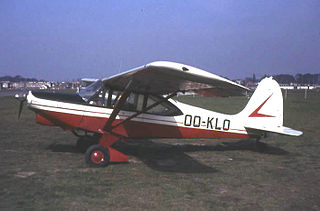
The Boisavia B.60 Mercurey was a series of four-seat light aircraft developed in France shortly after World War II.
The Boisavia B.260 Anjou was a four-seat twin-engine light aircraft developed in France in the 1950s. It was a low-wing cantilever monoplane of conventional configuration with retractable tricycle undercarriage. Intended by Boisavia as a touring aircraft, it did not find a market and only the single prototype was constructed. At this point, the firm sold the design to SIPA, which modified the design and re-engined it with Lycoming O-360 engines, but found that they could not sell it either. At a time when the twin-engine light plane market was already dominated by all-metal American aircraft, the Anjou's fabric-over-tube construction was something of an anachronism, and all development was soon ceased. Plans to develop a stretched version with three extra seats and Potez 4D engines were also abandoned.

The Farman F.500 Monitor was a 1950s Franco-Belgian two-seat training aircraft.
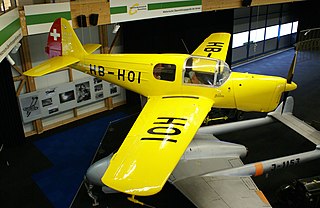
The Nord 1200 Norécrin is a French two or three-seat cabin monoplane designed and built by Nord Aviation.

The Hanriot H.170, H.180, and H.190 were a family of light utility aircraft produced in France in the 1930s. All introduced in 1934, they appeared side by side at the Paris Air Show that year, the model numbers distinguishing between versions powered by Salmson, Renault, and Régnier engines respectively.

The Morane-Saulnier MS.570 was a civil utility aircraft produced in small numbers in France in the late 1940s. It was a derivative of the MS.560 aerobatics aircraft with a revised fuselage design that added a second seat side-by-side with the pilot's and a more powerful engine.
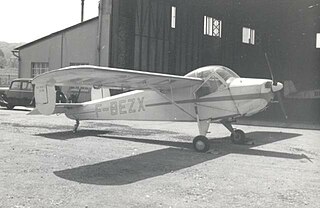
The Nord NC.850 was a light aircraft developed in France in the late 1940s for use by French aeroclubs, but which also saw military use as an airborne observation post.

The SECAN SUC-10 Courlis was a French high-wing touring monoplane designed and built by Société d'Etudes et de Construction Aéronavales (SECAN), a branch of the automobile company Société des Usines Chaussons. The aircraft had problems with the engine installation and only 144 were built, some without engines and were scrapped.

The SNCASO S.O.7050, S.O.7055, S.O.7056 and S.O.7060 Deauville were single-engine light French civil utility aircraft of the 1940s. Only two airframes were built but were modified with different undercarriages, engines and seating.
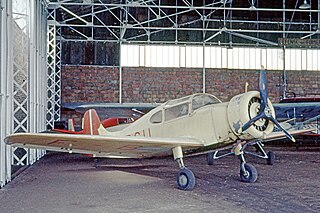
The Guerchais-Roche T.35 and T.39 was a small family of two, three and four seat French-built touring monoplanes of the 1940s.

The Sud-Est or SNCASE SE-2100, sometimes known as the Satre SE-2100 after its designer, was a tailless, pusher configuration touring monoplane with a single engine and cabin for two. Only one was built.
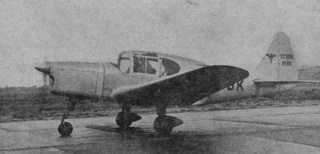
The Sud-Est SE-2300 or S.N.C.A.S.E. SE-2300 was a two/three seat low wing, single engine touring aircraft, built just after World War II in France. The SE-2310 was a tricycle undercarriage variant. Neither type went into production.
The Boisavia B.50 Muscadet was a prototype French three-seat cabin monoplane first flown in 1946.

The SNCAC NC.2001 Abeille was a single engine, twin intermeshing rotor helicopter designed and built in France in the late 1940s. Three were completed but only one flew, development ending when SNCAC was closed.
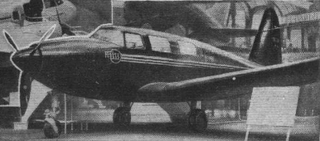
The SNCASO SO.7010 Pégase was a six-passenger light transport aircraft developed in France immediately after World War II. It was powered by a pair of tandem-coupled V-8 engines but this power plant proved to be too troublesome for development to proceed.
The SNCASO SO.3050 was designed and built in France towards the end of World War II. Only one was completed and that was soon abandoned.
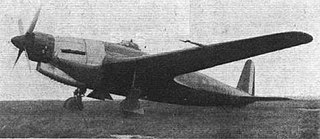
The SNCAC NC.3021 Belphégor was a French high altitude research aircraft designed and built at the end of World War II. Only one was completed and it was not a success, in part because of problems with its unusual engine.
References
- Notes
- 1 2 3 Gaillard 1990 , p. 49
- 1 2 Bridgman 1948, p. 134c
- Bibliography
- Bridgman, Leonard (1948). Jane's All the World's Aircraft 1948. London: Sampson Low, Marston & Company, Ltd.
- Gaillard, Pierre (1990). Les Avions Francais de 1944 à 1964. Paris: Éditions EPA. p. 49. ISBN 2-85120-350-9.
- Taylor, Michael J. H. (1989). Jane's Encyclopedia of Aviation. London: Studio Editions.
- Simpson, R.W. (1991). Airlife's General Aviation. England: Airlife Publishing. ISBN 1-85310-194-X.